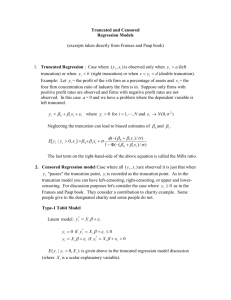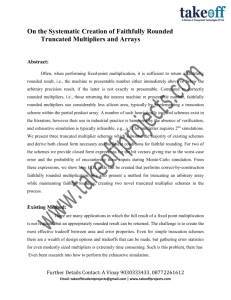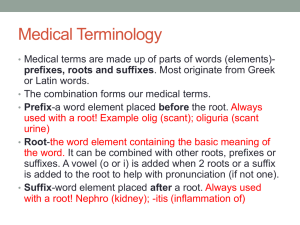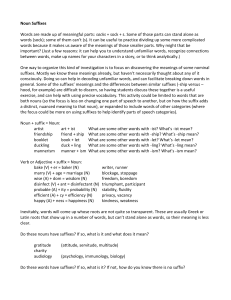Truncation in Montana Salish (with Lucy Thomason)
advertisement
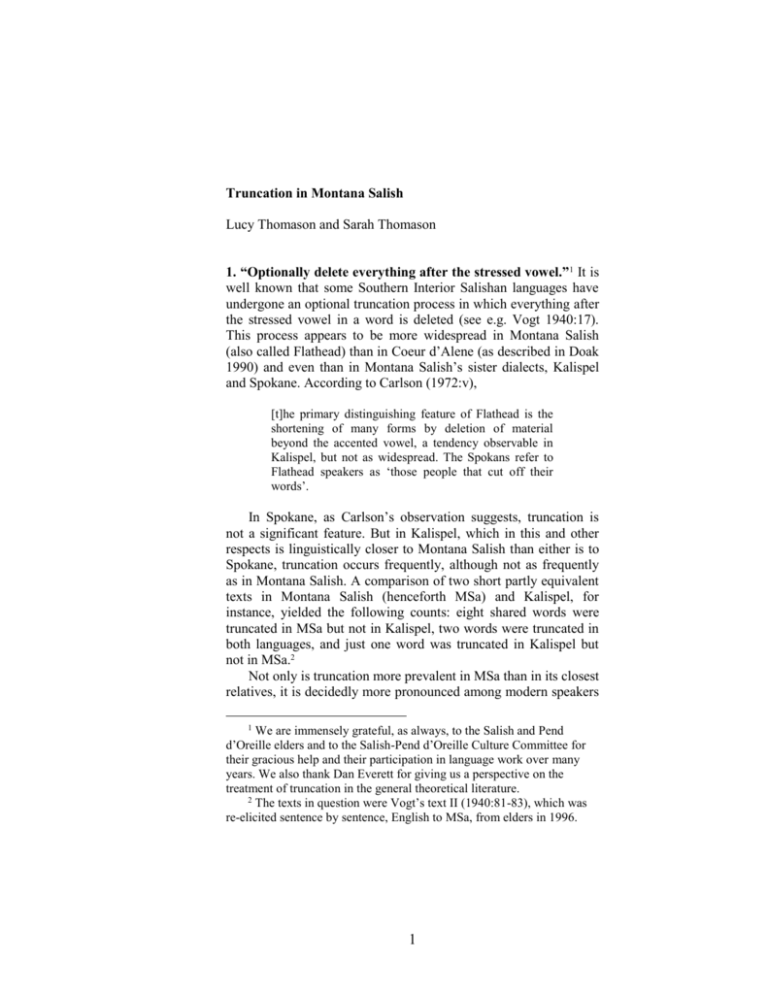
Truncation in Montana Salish Lucy Thomason and Sarah Thomason 1. “Optionally delete everything after the stressed vowel.”1 It is well known that some Southern Interior Salishan languages have undergone an optional truncation process in which everything after the stressed vowel in a word is deleted (see e.g. Vogt 1940:17). This process appears to be more widespread in Montana Salish (also called Flathead) than in Coeur d’Alene (as described in Doak 1990) and even than in Montana Salish’s sister dialects, Kalispel and Spokane. According to Carlson (1972:v), [t]he primary distinguishing feature of Flathead is the shortening of many forms by deletion of material beyond the accented vowel, a tendency observable in Kalispel, but not as widespread. The Spokans refer to Flathead speakers as ‘those people that cut off their words’. In Spokane, as Carlson’s observation suggests, truncation is not a significant feature. But in Kalispel, which in this and other respects is linguistically closer to Montana Salish than either is to Spokane, truncation occurs frequently, although not as frequently as in Montana Salish. A comparison of two short partly equivalent texts in Montana Salish (henceforth MSa) and Kalispel, for instance, yielded the following counts: eight shared words were truncated in MSa but not in Kalispel, two words were truncated in both languages, and just one word was truncated in Kalispel but not in MSa.2 Not only is truncation more prevalent in MSa than in its closest relatives, it is decidedly more pronounced among modern speakers 1 We are immensely grateful, as always, to the Salish and Pend d’Oreille elders and to the Salish-Pend d’Oreille Culture Committee for their gracious help and their participation in language work over many years. We also thank Dan Everett for giving us a perspective on the treatment of truncation in the general theoretical literature. 2 The texts in question were Vogt’s text II (1940:81-83), which was re-elicited sentence by sentence, English to MSa, from elders in 1996. 1 2 Truncation in Montana Salish than it was in the past, and it has in addition become lexicalized in a sizable number of morphemes. This trend has been noted with alarm by some elders: one tribal leader warned recently that, while elders keep the words long, younger people chop them off, and this must stop, or the words will disappear entirely. (His observation about age-grading was not entirely accurate; John Peter Paul, one of the Salish-Pend d’Oreille Culture Committee’s most respected elder consultants until his death in 2001 at the age of 92, was a more enthusiastic truncator of words than many speakers in their seventies.) At least since 1879, when the Jesuits’ dictionary of MSa was published (Mengarini et al. 1877–79), truncation has been a preferred pronunciation in some words. In certain words truncation has even become irreversible, as speakers have lost the thread of connection between truncated form and long form.3 This was true for some Kalispel words by 1940, when Vogt published his description of that dialect. In the last few generations, MSa has steadily added to its set of lexicalized truncated words. In addition to this, and more strikingly, the truncation process now sometimes affects material that precedes the last stressed vowel of the word. In section 2 we describe the basic patterns of MSa truncation. We claim that truncation can operate on any word in MSa, so long as critical grammatical information does not follow the stressed vowel of the word. In section 3 we discuss lexicalization of truncation. We claim that in some nouns and verbs, truncation has become standard if no critical grammatical information follows the stressed vowel of the word, and that in some nouns the full form has actually been lost. We show that the set of partly lexicalized truncated nouns and verbs and the set of wholly lexicalized truncated nouns have grown considerably in the last hundred years. In section 4 we discuss the conditioning factors that give rise to incidental, non-lexicalized truncation. We discuss two instances of hypertruncation. We conclude, in section 5, with brief comments on some theoretical implications of the MSa facts. 2. Simple truncation. The truncation rule in MSa is optional and is simply stated, although its scope in actual usage is complex and not predictable in any straightforward way. Here’s a somewhat 3 Not surprisingly, this process is somewhat idiosyncratic: which long forms are lost varies to some extent from speaker to speaker. Lucy Thomason and Sarah Thomason 3 frivolous formulation of the rule: “Delete everything after the stressed vowel of any word if you want to—but you won’t want to if there are crucial grammatical suffixes after the stressed vowel.” Only roots and suffixes are subject to truncation. Prefixes in MSa are never truncated, because MSa has no stressed prefixes. Truncation is absolutely blocked when any grammatical suffix follows the morpheme with the stressed vowel, unless the grammatical suffix in question is entirely predictable from the prefixation on the word—as is the case with the intransitive continuative suffix -mí/-i, when it co-occurs with the stative prefix es-,4 and the antipassive suffix -m, when it co-occurs with the agent prefix sxw-. Examples of truncated roots and truncated lexical suffixes are given in (1).5 In each case, the first line gives the full form of the 4 The situation with the stative prefix es- is actually more complicated than this simple statement indicates, because there is also a non-continuative construction in which the long form consists of es- and an unsuffixed stem; this form is most felicitously translated in English as a stative perfect, as in čn esc’éw’ ‘I’m washed’. This form contrasts with the active continuative čn esc’éw’i ‘I’m washing something’, and in principle either form may be truncated, yielding čn esc’é. In context, however, the two are very unlikely to be confused, because the stative perfect is formed from bivalent stems and the notional object is always the subject NP; by contrast, the intransitive continuative is an active form, and when the stem is bivalent, the intransitive continuative always has a notional patient other than the subject. The morphosyntactic and semantic differences between the MSa bivalent and monovalent stem classes are complex; for the present paper, the crucial point is that the subject of an unsuffixed bivalent stem is the patient, while the subject of an active unsuffixed monovalent stem is the actor. (See S. Thomason et al. 1994 and L. Thomason 1994 for discussion of bivalent and monovalent MSa stem classes). 5 In the morpheme-by-morpheme glosses for these examples, hyphen (-) marks prefixes and all suffixes except lexical suffixes; equals sign (=) marks lexical suffixes. 1SG.AGENT stands for the first-person singular agent marker; 1SG.EMPH for the first-person singular emphatic pronoun; 1SG.INTR.SUBJ for the first-person singular subject of an intransitive verb; 1SG.POSS for the marker of first-person singular possessor; 1PL for the first-person plural marker; 1PL.AGENT for the first-person plural agent marker; 2NDARY for the secondary determiner; 2SG.AGENT for the secondperson singular agent marker; 2SG.EMPH for the second-person singular emphatic pronoun; 2SG.INTR.IMPV for the second-person singular 4 Truncation in Montana Salish verb or noun, and the second line gives the truncated form. Starred truncated forms are incoherent: we have no naturally-occurring instances of them, and the MSa speakers we have consulted judge them to be ungrammatical. (1) a. qwlqwél. qwlqwé. qwl-qwél REDUP-talk ‘S/he talks/talked.’ b. qwlqwélstm. * qwlqwé. qwl-qwél-st-m REDUP-talk-TRANS-BCK.AG ‘Someone talks/talked to him/her.’ c. čn čn čn 1SG.INTR.SUBJ ‘I hurry/hurried.’ χwełéčst. χwełé. χweł=éčst hurry=hand d. čn čn esχwełéčsti. esχwełé. intransitive imperative marker; 2SG.POSS for the marker of second-person singular possessor; 2PL.POSS for the marker of second-person plural possessor; 3.AGENT for the third-person agent marker; 3.POSS for the marker of third-person possessor; AGENT for the agent prefix; ANTIPASSIVE for the antipassive marker; BCK.AG for the backgrounded agent marker; CNCTV for the compound verb connector; DEM for demonstrative; DERIVED.TRANS for the derived transitive marker; DET for determiner; DIM for diminutive; FUT for the future marker; INCH for the inchoative suffix; INST for instrumental suffix; INTR.CONT for the intransitive continuative marker; INTR.REFL for the intransitive reflexive marker; IRREAL for the irrealis marker; LOC for locative prefix; NEG for the negative particle; NOM for nominalizer; OBL for the oblique determiner; RECIP for the reciprocal marker; REDUP for reduplicated morpheme; REFL for the reflexive marker; RELATIONAL for the relational ditransitive marker; STAT for the stative prefix or stative suffix; TRANS for transitive marker. Lucy Thomason and Sarah Thomason 5 čn 1SG.INTR.SUBJ ‘I’m hurrying.’ es-χweł=éčst-i STAT-hurry=hand-INTR.CONT e. χwełéčstš! * χwełé! χweł=ečst-š hurry=hand-2SG.INTR.IMPV ‘Hurry!’ f. sxwnt’púsm sxwnt’pú sxw-n-t’p=ús-m AGENT-LOC:in-boil/cook=fire-ANTIPASSIVE ‘a cook’6 In (1a), an optional process of truncation deletes the final consonant of the root. In (1b), truncation is not an option. If it operated, it would delete two grammatical suffixes which would not be recoverable from the context. In (1c), optional truncation deletes all but the initial vowel of the lexical suffix =éčst ‘hand’. In (1d), optional truncation deletes the final consonants of =éčst AND the intransitive continuative suffix -i (-/mí/), a grammatical suffix whose presence is implied by the presence of the stative prefix es(but see footnote 4). In (1e), truncation is not an option. If it operated, it would delete a grammatical suffix which would not be recoverable from the context. And in (1f), optional truncation deletes the final segment of the lexical suffix -ús AND the antipassive suffix -m, a grammatical suffix that forces an active reading of a bivalent stem and is semantically redundant in the presence of the agentive prefix sxw- (see footnote 4 for the distinction between bivalent and monovalent stems). Examples of truncated grammatical suffixes are given in (2–4). By far the most common of the grammatical suffixes that carry stress, and hence can be truncated, is the reflexive suffix -cút: 6 As our nominal translation suggests, words in sxw- generally function as NPs. Like every full MSa word, however, they can also be predicates, as in či sxw-het-łtú ‘I’m a teaser’ (lit. 1SG.INTR.SUBJ AGENTtease-people’). 6 Truncation in Montana Salish (2) a. ?* plscút. plscú. púls-s-cút kill-TRANS-REFL ‘S/he committed suicide.’ b. yo|wmncút. yo|wmncú. yo|w-mí-nt-cút strong-DERIVED.TRANS-TRANS-REFL ‘S/he gets/got tensed up.’ c. yo|wmncútš! * yo|wmncú! yo|w-mí-nt-cút-š strong-DERIVED.TRANS-TRANS-REFL-2SG.INTR.IMPV ‘Watch out!’ In word-final position, in modern MSa, reflexive -cút nearly always appears as truncated -cú. In (2a) the full form plscút may now be considered ill-formed. Both full and truncated forms of yo|wmncú(t), in (2b), were produced in an elicitation session. In (2c), truncation is impossible because of the imperative suffix following the reflexive. Like reflexive -cút, reciprocal -wéxw nearly always occurs in its truncated form in word-final position: (3) a. ?* qe q’wmnwéxw. qe q’wmnwé. qe q’wm-n-wéxw 1PL put.flexible.object-TRANS-RECIP ‘We wrestle/wrestled.’ b. qe esq’wmnwéxwi. qe esq’wmnwé. qe es-q’wm-n-wéxw-i 1PL STAT-put.flexible.object-TRANS-RECIP-INTR.CONT ‘We’re wrestling.’ In (3a), the full form may be infelicitous or even ungrammatical nowadays, like ?* plscút in (2a). Both full and Lucy Thomason and Sarah Thomason 7 truncated forms are fully acceptable in the continuative construction in (3b), however. Compare čn esχwełé(čsti) in (1d). The so-called intransitive reflexive suffix -míst occurs wordfinally in both truncated and full forms. However, some nouns that end in this suffix occur only in truncated form: (4) a. xwč’šmíst. xwč’šmí. xwíc’-š-míst give-RELATIONAL-INTR.REFL ‘S/he surrendered (gave herself/himself).’ b. ?* tumíst. tumí. tw-míst buy-INTR.REFL ‘S/he buys/bought something.’ c. tumístis * tumí tw-míst-nt-és buy-INTR.REFL-TRANS-3.AGENT ‘S/he bought the house.’ łu łu łu 2NDARY cítxw. cítxw. cítxw house d. * sntumíst sntumí s-n-tw-míst NOM-LOC:in-buy-INTR.REFL ‘store’ Both full and truncated forms for xwč’šmí(st) in (4a) were produced in an elicitation session. The verb ‘buy’ is invariably truncated in modern MSa whenever -míst is word-final, as in (4b). Again, truncation is impossible when most other grammatical suffixes follow, as illustrated by (4c). The noun sntumí in (4d) is always truncated. 3. Lexicalization of truncation. 3.1. Lexicalization in verbs. It turns out, perhaps surprisingly given the relative weakness of the lexical distinction between 8 Truncation in Montana Salish nouns and verbs in MSa and other Salishan languages, that nouns and verbs behave differently under truncation. In verbs, even when (as often happens) speakers are unable to think of ‘the long form’ when asked for it, the long forms pop up when indispensable grammatical suffixes are added to the stem. Some verbs do have fairly freely alternating short and long forms, even when the morpheme containing the stressed vowel is word-final; an example is the root %ác’χ ‘watch (something)’, in which the truncated intransitive continuative form esc%á ‘she was (is) watching them’ alternates with the full form esc%ác’χi ‘she is (was) watching them’. Other verbs are routinely truncated when possible, for instance w /χ eł=éčst/ ‘hurry’ (the lexical suffix means ‘hand’ and is semantically opaque here; see also examples (1c)–(1e) above). Elders always give a truncated form when asked for a translation of a simplex construction with this stem, e.g. čn χwełé ‘I hurry/hurried’, and they can’t all provide the long form on request. But the full form surfaces in a suffixed construction like the singular intransitive imperative: χwełéčstš! ‘hurry!’. Verb stems that end in grammatical suffixes containing a stressed vowel pattern with χwełé(čst): they are routinely truncated in word-final position in modern MSa.7 So, for instance, reflexive -cút occurs word-finally in full form in only nine tokens in our data, compared with several hundred tokens of word-final -cú. Intransitive reflexive -míst occurs word-finally in full form in only five tokens in our data, compared with more than a hundred tokens of word-final -mí. Reciprocal -wéxw occurs word-finally in full form in only one dubious token in our data, compared with several dozen tokens of word final -wé. Occasionally a verb appears in truncated form mainly in nominalized and (apparently) stylistically marked verbal constructions. The root %ócqe% ‘go outside’ usually occurs 7 With one important set of exceptions: several agent suffixes often occur stressed in word-final position but are never truncated. Examples are -én ‘1SG.AGENT’, -éxw ‘2SG.AGENT’, and -és ‘3.AGENT’. The reason for the lack of truncation in these morphemes is obvious: the suffixes in this set begin in -é but end in different consonants. Truncation would make these suffixes uninterpretable. Thus we have here a subcategory of the general principle that truncation cannot occur if it would result in the loss of crucial grammatical material. Lucy Thomason and Sarah Thomason 9 untruncated, as in čn %ócqe% ‘I went outside’; and of course the full form always appears when the root is followed by indispensable grammatical suffixes, as in the causative construction %óccqests ‘he let them out’ (with inchoative C2 reduplication). But the root is truncated in the nominalized form sčł%ó ‘measles’, in the fixed adverbial expression č’č’ó ‘outside’, and in the baby-talk expression χey’ n’é tn %ó ‘I might have to go outside [to the potty]’. (In this last form the first-person singular intransitive subject pronoun tn is baby-talk for čn.) 3.2. Lexicalization in nouns. It is clear that for verbs, at least, the underlying forms are the full forms: speakers have the knowledge to produce the long forms when they’re needed, and they’re needed whenever grammatically and semantically crucial suffixes are added to the stem. The situation is strikingly different with nouns. Many truncated nominal forms are clearly lexicalized, so that they are in fact the underlying forms; the etymological full forms are no longer internalized for modern speakers. There is of course some variation: some elders know long forms that others don’t, and long forms do sometimes surface in alternation with truncated forms, even when the truncated forms occur much more frequently. But for many nouns there appear to be no long forms at all in modern MSa. Some of these truncated forms end in stressed root-vowels, but most end in stressed lexical suffixes, so that what is truncated is the lexical suffix. As Vogt noted decades ago for Kalispel (1940:17), Final -á may represent -áqs ‘nose, road’ or -ásq’at ‘day, sky’, -é may represent -élxw ‘skin’, -ép ‘door, hair’, -éčst ‘hand’ etc. When the feeling of the abbreviated forms as secondary forms of the full word is lost, the abbreviated form becomes an independent word whose relation to the stem is not always clear. An example of a consistently truncated root is the word for knife, łn’í (a diminutive formation from the root níč’ ‘cut’, with a diminutive prefix and glottalization of the resonant consonant). The root is never truncated (in our data) in verbal contexts; even in the rare cases when a verbal form of ‘cut’ is word-final, the root appears in its full form, e.g. esníč’ ‘it’s cut’. 10 Truncation in Montana Salish A more typical example of a truncated noun stem is st’šá ‘huckleberry’ (literally ‘sweet berry’), formed from the root t’íš ‘sugar, sweet’. The bare root always (in our data) appears in the full form, as in i t’íš ‘it’s sweet’. The derived noun st’šá, with an etymological suffix =áłq ‘root, berry, fruit’, is invariably truncated. Compare the full forms in Spokane st’šáłq, in Kalispel st’ša(łq) (optionally truncated), and in Coeur d’Alene st’šástq (with a different lexical suffix). What happens when indispensable suffixes are added to a truncated noun stem? In some cases, the long form of the noun stem surfaces, just as when indispensable grammatical suffixes are added to a truncated verbal stem. In these situations we can conclude that the underlying form of the noun must be the long form, and that the truncation rule is treated as obligatory when the stem is word-final, as in the case of verb stems like χwełé. In other cases, the suffix is added directly to the truncated stem. In still other cases, a consonant (usually /h/, occasionally /s/) is inserted between the truncated stem and the suffix (see below for examples). In these last two situations, we can conclude that the truncated form is completely lexicalized, and that the stem’s underlying form and surface form alike end in a stressed vowel. Only two suffixes are readily available to test speakers’ suffixing strategies for truncated noun stems: the second-person plural possessive suffix -mp and the third-person possessive suffix -s. (It’s possible that additional tests could be made with verbal suffixes added to noun stems to form words with meanings like ‘you turned into coffee’, but speakers are understandably reluctant to come up with such weird forms in elicitation sessions, and any translations they do provide are periphrastic constructions.) An example in which the long form always surfaces under possessive suffixation is the word for ‘dog’. The unsuffixed form is always nq’wq’wsm’í (except in certain discourse contexts: see section 4), but in the possessed form the possessive suffix is added to the etymologically expected long stem: n-q’w-i-q’ws-m’=íčn=ši-s ‘his dogs’ (where prefixal -i- marks the plural). A similar example is the word for a brown horse, which is normally truncated as čłč’é, but the suffixed form is long: čłč’éλ’ixw-s ‘his brown horse’ (cf. Spokane čłč’éλ’xw ‘brown horse’ and Colville kλ’k’aλ’lxw ‘brown horse’). The other two strategies are extremely common in citation forms and fairly common in naturally-occurring data—where they Lucy Thomason and Sarah Thomason 11 would no doubt be more common if possessed forms were more frequent. A few examples are given in (5).8 Some of these nouns display variation among speakers, who are coded by numbers after the examples. (5) a. kwlkwlés (#1) kwlkwléhs (#2) kwl-kwíl=é-s REDUP-red=?-3.POSS ‘his/her woodpecker or flicker with red on it’ (cf. Spokane kwl-kwl=éče% ‘flicker’) b. smłíčs (#1) smłíhs (#2) smłísc (#4) s-młí(č)-s NOM-salmon-3.POSS ‘her/his salmon’ (cf. Spokane and Kalispel s-młíč ‘salmon’) c. čqq’m’éy’es (#3) čqq’m’és (#2, 1996) čqq’m’éhs (#2, 1997) č-q-q’m=é(y’e%)-s LOC:to-REDUP-swallow=hook(?)-3.POSS ‘his/her fishing pole’ (cf. Spokane č-q’q’m’=éy’e%-tn ‘fishing pole’) d. č’e%múhs (#2) č-%emú-s LOC:to-sit-3.POSS ‘her/his pet’ (lit. ‘perched on’) (cf. Spokane č’-em’út-n’ ‘caged up pet’) e. sčłq’wáhmp (#5) s-č-łóq’w=á-mp NOM-LOC:on-peel=?-2PL.POSS your bark bags (cf. Spokane s-c-č-łq’w=álqw ‘bark basket’) 8 For further examples, see S. Thomason (2002). 12 Truncation in Montana Salish The noun in (5a) never occurs with a full lexical suffix, and current elders don’t recognize the (presumably original) Spokane form; the identity of the original lexical suffix therefore cannot be established on the basis of modern MSa data, and the truncated form is completely lexicalized. Two elders use different strategies for possessive suffixation. The elders say that the word for salmon (5b) is no longer used on the reservation, although they still remember it. Older MSa documents (e.g. Mengarini et al.) attest to the earlier form smłíč. One elder provided the long form when asked for a third-person possessed form, but others added different dummy consonants before the possessive suffix.9 Example (5c) is more complex. On at least one occasion, elders offered a full form before the possessive suffix, apparently untruncated—unless, like Spokane, the original word for fishing pole also had the instrumental suffix -tin, in which case the modern MSa form is idiosyncratically truncated (this word is not attested in Mengarini et al.). Otherwise, the stem occurs truncated, both with and without a suffix. The two truncated possessed forms were provided by the same elder in different years, although this elder usually inserted a dummy /h/ between a truncated stem and a possessive suffix. The stem č’e%mú in (5d) is invariable; no fuller form occurs in MSa. This suggests that the link between the derived noun ‘pet’ and the verb ‘sit’ has been severed lexically in the modern language. The stem for ‘bark basket’ in (5e) is always truncated, so here again the identity of the original lexical suffix can’t be determined on the basis of modern MSa data. It may well be that the small number of semantically crucial nominal suffixes—only the second-person plural and third-person possessive suffixes, as noted above—is responsible for the striking difference in the behavior of truncated nouns as opposed to truncated verbs. Several grammatical verbal suffixes are vital to the meaning of the word, in particular the transitivizing and 9 The final -sc sequence consists of the dummy coda -s followed by the third-person possessive suffix -s, which is then dissimilated to the affricate -c. Most elders routinely add a dummy consonant, either h or s, to a lexicalized truncated stem before a possessive suffix; see Thomason 2002 for discussion. Lucy Thomason and Sarah Thomason 13 transitive morphology and accompanying patient and agent suffixes; and the suffixed formations are sufficiently frequent that they can reasonably be supposed to have prevented lexicalization of truncated verb stems. Even nouns that are felicitously possessed probably don’t occur often enough in natural discourse to keep the long form of a truncated simplex noun in speakers’ minds, or to permit child learners to acquire it (in the days when MSa was still learned by children as a first language). And the fact that many or most nouns are not naturally possessed (it’s hard to elicit forms like ‘his cow elk’, even with a hunting context provided) contributes to the low frequency of crucially suffixed nominal forms. 3.3. Lexicalization in 1841–1879 compared with lexicalization in 1980–2003. In the Jesuits’ dictionary of MSa, the lexical entries are given as full forms, almost exclusively. In a handful of cases, the full form is omitted, or is cited side by side with a truncated alternative. Truncated forms also occur in the 2,314 example sentences scattered throughout the 644-page Salish-English volume of the dictionary. These example sentences are clearly intended to represent natural speech. The truncated forms that occur in them demonstrate two things: first, that truncation was already partly lexicalized in MSa in 1879, and second, that the process of lexicalization was far less advanced than it is in 2003. Only twelve words are cited in the Jesuit dictionary in truncated form alone. Three are three names for days of the week. ‘Tuesday’, ‘Wednesday’, ‘Thursday’ and ‘Friday’ have similar forms and are cited together. All four names end in the lexical suffix =á(sq’t) ‘day’; ‘Tuesday’ is given in full form, ‘Wednesday’, ‘Thursday’ and ‘Friday’ are given in truncated form, and a note following the whole entry states that the truncated forms of all four names are used by many speakers. One is a derivative of the word for ‘huckleberry’ (the main entry for ‘huckleberry’ gives both truncated and full forms), three are derivatives of the word for ‘cow’ (the main entry for ‘cow’ gives both truncated and full forms), one is a verb for a sexual practice the priests disapproved of (cited elsewhere in both truncated and full forms), and four are four of the fourteen entries for the verb stem χwełé(čst) ‘hurry’ (including the root entry, which Mengarini et al. give as <CHIN-GOETLE> = čn χwełé ‘I hurry’). 14 Truncation in Montana Salish Note that all twelve forms mentioned in this list occur in long form at least once, at least in one variant, in the Jesuits’ dictionary. In addition to the twelve words just mentioned, twenty-odd words are cited in the Jesuits’ dictionary in both truncated and full form. For instance, ‘huckleberry’ is cited as <Stishà, stishálk> (cf. section 3.2). In modern MSa, this noun has become lexicalized in its truncated form (cf. the discussion in section 3.2, and the fact that the third-person-possessed form of this noun is now st’šáhs). All the forms cited in truncated as well as full form by Mengarini et al. tend to occur in truncated form in the example sentences they appear in. The exception is the word for ‘Blackfeet’, which is cited in full form first—<S’chkoéishin, s’chkoé>—and which appears five times in full form and only once in truncated form in the example sentences. In modern MSa, this noun (lit. ‘black feet’) occurs as truncated sčq’wé—except in citation, when speakers have no trouble producing the long form sčq’wéysšn. In addition to these, several words that are cited in full form occur only in truncated form in the example sentences they appear in. For instance, snqwl’pú(lexw) ‘(baked) bread’ is cited as <SNKOLPÓLEGU>, but also occurs in seven example sentences, each time as <snkolpó>. In modern MSa, this noun occurs only as snqwl’pú. The Jesuits’ dictionary provides evidence that truncated forms were already in use in nineteenth-century MSa. For at least a few words, the truncated was the preferred form; that is, some truncations were on the way to lexicalization. However, Mengarini et al.’s consultants must still have commanded the long forms of every truncated form they produced, since for every truncated form recorded in the dictionary, a full form is also given somewhere. So no truncations were fully lexicalized at the time when the Jesuits’ dictionary was produced. The suffixes which in modern MSa are near-obligatorily truncated if no other suffixes follow them—grammatical suffixes such as the reflexive -cút and lexical suffixes such as =sqáχe% ‘domestic animal’—occur in the Jesuits’ dictionary in untruncated form only. There is one suggestive exception. In addition to several dozen instances of partially lexicalized truncation, the Jesuits’ dictionary contains one instance of a truncated form that is clearly motivated by its context. The lexical suffix =sqá(χe%), which in modern MSa occurs word-finally only as -sqá, occurs in the Lucy Thomason and Sarah Thomason 15 Jesuits’ dictionary both medially and finally as -sqáχe% (<skágae>), except in the following sentence: (6) nxwlxwíltn n-xwl-xwíl-tin LOC:in-REDUP-live-INST way of life łu łu 2NDARY DET łu łu 2NDARY DET %eyméw’s, %éym=éw’s cross=middle cross nč’áwmn, n-č-%áw-min LOC:in-LOC:to-call.out-INST prayer snqwl’pú, s-n-qwl’-p=úlexw NOM-LOC:in-bake-INCH=earth (baked) bread snčłc’a%sqá. s-néč=ełc’a%=sqáχe% NOM-elk=body=domestic.animal horse ‘Cross, prayer, bread, horses are wholesome, keeping or giving life to soul or body.’10 The word for ‘horse’ in (6) is presumably influenced by the fact that the preceding word, ‘bread’, is truncated. This word occurs four other times in the Jesuits’ dictionary, each time as <snchilzaskágae> = snčłc’a%sqáχe%. 4. Non-lexicalized (incidental) truncation. 4.1. Conditioning factors for incidental truncation. Truncation tends to occur, as Doak states (1990:2), “like English contraction…as a matter of convenience.” In section 2 we stated the truncation rule more or less as, “Delete everything after the stressed vowel unless it’s important.” A better formulation might 10 Translation as in Mengarini et al. A better translation might be ‘The cross, prayer, bread, and horses are what give life.’ 16 Truncation in Montana Salish be, “Delete everything after the stressed vowel if the context makes completely unambiguous what the deleted material must be.” So, for instance, truncated forms of bare verbal roots—like c’á ‘it hurts’ (from /c’%ál/) and łá ‘he sat’ (from /łáq/)—are rare, but truncated forms of reduplicated roots—like qwlqwé in (1a) (from qwlqwél)—are common. A truncated reduplicated root contains a version of the deleted consonant. Similarly, discourses that contain incidental (rather than lexicalized) non-reduplicated truncated words typically also contain at least one untruncated version of the word. In these cases the untruncated version of the word always precedes the truncated form. Examples are given in (7–8) (relevant forms in boldface): (7) Čoní Čoní Johnny Johnny u u and and či čn I I nté nt=éls want=feelings wanted qwoyjé qwoyjé 1SG.EMPH me qłnóχwnχws qł-nóχw-nχw-s IRREAL-wife-REDUP-3.POSS his future wife čn čn 1SG.INTR.SUBJ I Malí, Malí Mary Mary nté nt=éls want=feelings wanted qstixwłnó qł-s-tixw-ł-nóχw-nχw IRREAL-NOM-get-CNCTV-wife-REDUP will get a wife l l Tlé. Tlé OBL Teresa DET Teresa ‘Johnny wanted to marry Mary, and me, I wanted to marry Teresa.’ The contrasting halves of (7) are structurally similar but not exactly parallel. The first clause has an irrealis noun ‘wife’ with third-person possessor, and the second clause has an irrealis compound verb ‘get a wife’ with first-person subject. Both noun and verb underlyingly contain the noun stem nóχwnχw ‘wife’ (a stem which is always reduplicated in MSa); the first clause has the full form of the noun, and the second clause has the truncated form of the verb. Compare Hayo qstixwłnóxχwnxχws! ‘Hey, he’s going to get a wife!’ with či qstixwlnó. In the case of Hayo qstixwłnóxχwnxχws! the marriage is new, exciting information. Lucy Thomason and Sarah Thomason 17 In (7), čn nté či qstixwłnó is the most familiar, routine part of the sentence; the contrastive emphasis is on the subject and object of the verb. (Note by the way that ntéls is partly lexicalized as truncated nté, when no other suffixes are tacked on to it.) Truncation, then, in some cases does a little more work in MSa than Doak ascribes to it for Coeur d’Alene (“Truncation does not add any meaning to a form, except perhaps to imply convenient or casual speech”—Doak 1990:10). Truncation can “defocus” the truncated form, reinforcing a special emphasis elsewhere in the sentence. Consider example (8): Čoní Čoní Johnny Johnny (8) T t OBL DET χménčs χm=énč-s like=belly-3.POSS his liking Inχménč in-χm=énč 1SG.POSS-like=belly my liking Tam Tam NEG not Čoní Čoní Johnny Johnny anχmé an-χm=énč 2SG.POSS-like=belly your liking asa%éy’me an-s-a%éy’m=e 2SG.POSS-NOM-hate=? your hating łu inpús. łu in-pús 2NDARY 1SG.POSS-cat DET my cat púsc. pús-s [cf. fn8] cat-3.POSS his cat Čoní Čoní Johnny Johnny łu łu 2NDARY DET púsc; pús-s cat-3.POSS his cat pús. pús cat cat ‘Johnny likes my cat. I like Johnny’s cat. You don’t like Johnny’s cat; you hate cats.’ The discourse in (8) contains three instances of the noun χménč ‘thing liked’. The first two are untruncated, and the third is truncated. Truncated anχmé fulfils the two conditions necessary for incidental truncation: it is completely unambiguous in (8), and it is a good candidate for defocusing, since there’s a strong contrastive emphasis elsewhere in the sentence, on the negative. 18 Truncation in Montana Salish When these two conditions are met, in modern MSa, truncation can affect words that fail to meet the original phonological condition of the rule. Consider examples (9–10): (9) Č’e č-%e LOC:to-DEM at that sec’é s-ec’=éwt NOM-last=place the last u u and and k’włčíc k’wł-číc LOC:under-arrive he arrived nłq’wq’wsm’í, n-ł-q’w-q’ws-m’=íčn=šín LOC:in-DIM-REDUP-bunched.up-?=back=foot little dog łk’wk’wn’ú ł-k’w-k’wín’=ú DIM-REDUP-little=? very little nłq’wq’wsm’í. n-ł-q’w-q’ws-m’=íčn=šín LOC:in-DIM-REDUP-bunched.up-?=back=foot little dog u u and and cúntm, cú-nt-m say-TRANS-BCK.AG somebody told him “tam tam NEG not esyapqíni! es-ya%-p=qín-i STAT-gather-INCH=head-INTR.CONT gathering kwkwtúnt kw-kwtún-t REDUP-big-STAT big χwl’ χwl’ for for anwí anwí 2SG.EMPH you χwl’ χwl’ for for nq’wo.” n-q’w-q’ws-m’=íčn=šín LOC:in-REDUP-bunched.up-?=back=foot dog ‘At the very last a little dog got there, a really little dog. And they told him, “This meeting’s not for you! It’s a Lucy Thomason and Sarah Thomason 19 meeting for big dogs.”’ The word nq’wq’wsm’í ‘dog’ is the result of an early truncation, now partly lexicalized. It is cited in Mengarini et al. as <KOKOSMECHINSHIN>, but turns up as truncated <kokosmè> in one of the Jesuits’ example sentences. In modern MSa, as described in section 3.2, it surfaces in long form when suffixes are added to it—for instance, in third-person-possessed nq’wq’wsm’íčnšis—but otherwise occurs exclusively in truncated form. The example in (9) is taken from a story entitled “Why Dogs Sniff Each Other”. In this passage, the word for ‘dog’ occurs twice in its lexicalized truncated form, and once as hypertruncated nq’wo. Again, nq’wo meets the two necessary conditions for incidental truncation: it’s highly familiar—completely unambiguous—in (9), and the storyteller gives a strong contrastive emphasis to kwkwtúnt ‘big’. Another example of hypertruncation is given in (10): (10) Ye ye DEM here l l OBL DET l l qe qe OBL 1PL DET our snčay’uté s-n-č-ay’=éwt=éw’s NOM-LOC:in-LOC:to-sit.pl=place=middle riding horses (lit. what we sit on) snčłc’á s-néč=éłc’e%=sqáχe% NOM-elk=body=domestic.animal horse m m qe qe FUT 1PL will we k’włq’eyq’éyntm k’wł-q’ey-q’éy-nt-m LOC:under-REDUP-paint-TRANS-1PL.AGENT we paint something on łu łu 2NDARY qe qe 1PL our DET suméš. suméš medicine.power medicine power ‘We’ll paint pictures of our medicine power on our riding horses.’ 20 Truncation in Montana Salish In (7) and (8) the untruncated and truncated words have the same root but are not identical. In (9) the garden-variety truncated and hypertruncated words also have the same root but are not identical. In (10) the garden-variety truncated and hypertruncated words have completely different roots, but are synonyms. The noun snčay’utéwtew’s ‘riding horses’, which in the Jesuits’ dictionary occurs only in full form, in modern MSa is routinely truncated as snčay’uté. The noun snčłc’a%sqáχe% ‘horse’, which in the Jesuits’ dictionary occurs only once in truncated form (see section 3.3), in modern MSa is routinely truncated as snčłc’a%sqá. In (10) it is shortened even futher, to snčłc’á. The narrative that (10) is taken from describes a scrape two young men get into. The sentence in (10) is a dramatic juncture in the story: it’s the point where one of the two friends announces his rash idea—his worse than rash, comically terrible idea, that is bound to lead to trouble. He’s already misled his friend about his intentions, since he’s pretty sure his friend is going to disapprove. The second noun for horse in (10) is not needed for clarity; it’s rather thrown in to delay the big pay-off of the second part of the sentence. It simultaneously marks the speaker’s hesitation over how his proposal will be received, and allows the narrator to prolong his audience’s anticipation of the joke they know is coming. Hypertruncated snčłc’á is completely unambiguous in (10), following as it does on the heels of another word for ‘horse’. There’s no strong contrastive stress elsewhere in (10), but every element of (10) except snčłc’á is highly important, heavily underlined information. One or both of these facts is clearly enough to permit hypertruncation of snčłc’a%sqá. It’s worth noting that the hypertruncated forms in (9) and (10) both occur in quoted speech within a narrative. It may be that Doak’s suggestion that truncation is sometimes used to indicate colloquial speech is relevant here. 4.2. Lexicalization of truncation revisited. If one of the necessary conditions of non-lexicalized truncation is that the “context makes completely unambiguous what the deleted material must be”, how is it that truncations ever become lexicalized? Well, speakers’ judgements about what’s completely unambiguous depends both on universal pragmatic principles and on an enormous amount of language-specific knowledge. For instance, Lucy Thomason and Sarah Thomason 21 -cút and =sqáχe% remain completely unambiguous after truncation, because the part of the suffix that remains— respectively, -cú and =sqá—suffices to identify these morphemes uniquely. It so happens that there are no other suffixes in MSa that begin with just these sequences. To know this, you must be familiar with every suffix of MSa. A native speaker of MSa is justified in assuming that every other native speaker of MSa has this knowledge. Consider again the noun st’šá ‘huckleberry’. This noun is lexicalized in truncated form in modern MSa. For a speaker who was familiar with its original form, st’šałq, it would be natural to assume that every other speaker of MSa knew this long form. And since no MSa word that is unrelated to huckleberries begins with the sequence st’šá, st’šá is in most contexts a completely unambiguous rendering of st’šáłq. It is easy to see how a rarelypossessed noun like /st’šáłq/, once it became partly lexicalized as st’šá, could get reinterpreted as /st’šá/ by a speaker who had never heard the long form. A more interesting question is how partial lexicalization takes place. If the second necessary condition for incidental truncation is a strong emphasis on some other part of the sentence, then there ought be far too many non-truncated focused (or at least not defocused) instances of nouns like st’šáłq for partial lexicalization of truncation ever to become a pattern in the language. We can only assume that there are two competing interpretations of truncation active in MSa—one of them matching Doak’s suggestion of sheer convenience—and that the first of the two conditions (speaker believes that the context makes completely unambiguous what the deleted material must be) is often sufficient for truncation to be applied. 5. Conclusion. The theoretical literature on truncation focuses exclusively, or almost so, on truncation as a morphological process, for instance in hypocoristic formations (e.g. Poser 1984, Mester 1990, Prieto 1992, Colina 1996) and more generally (e.g. Weeda 1992, Benua 1995). The truncation processes discussed in the literature do not closely resemble the MSa truncation process we’ve described in this paper. Unlike most or all instances of truncation that are already in the general literature, the Southern Interior Salishan processes are not specific to any morphological category, but are quite general across word classes—although they 22 Truncation in Montana Salish are subject to a general morphological constraint that prohibits deletion of crucial grammatical information. Its novelty makes Salish truncation especially interesting. The constraint on the Salish process is reminiscent of Chomsky’s ‘deletion up to recoverability’ constraint in syntax, according to which ‘...a pure complementizer that and intermediate traces can be deleted, but WH-phrases, which clearly have semantic content, cannot’ (Lasnik & Saito 1992:60, citing earlier work by Chomsky & Lasnik). This suggests, as Dan Everett points out (p.c. 2003), that a constraint that is needed for syntactic analysis is also needed in the phonology. (We should note that we are using the word ‘constraint’ here in its ordinary-English sense of absolute prohibition, not in the Optimality Theory sense of a violable constraint.) Southern Interior Salish truncation is remarkable as a process whose basic formulation is strictly phonological (“delete everything after the stressed vowel of each word”) but whose secondary restrictions are semantic and pragmatic (“don’t apply if important information would be lost”; “apply in cases of marked defocusing”; “apply in cases of marked colloquial speech”). In Montana Salish we have the opportunity to study what has happened as truncation shifted from a transparent operation that affected only surface forms to a partly lexicalized, partly productive operation that has altered the shape of a number of underlying forms. In the course of this shift, MSa truncation has called at least two new grammatical operations into being: special marking for vowel-final nouns in case of a suffixed possessor, and radically truncated forms such as snčłc’á and nq’wo. References Benua, Laura. 1995. Identity effects in morphological truncation, in Jill N. Beckman et al. (eds.), University of Massachusetts Occasional Papers 18:77–136. Carlson, Barry F. 1972. A Grammar of Spokan. Honolulu: University of Hawaii dissertation. Colina, Sonia. 1996. Spanish truncation processes: The emergence of the unmarked, Linguistics 34:1199–1218. Doak, Ivy. 1990. Truncation, í-suffixation, and extended vowel length in Coeur d’Alene, ICSNL 25:97–109. Lucy Thomason and Sarah Thomason 23 Lasnik, Howard, and Mamoru Saito. 1992. Move-Alpha: Conditions on Its Application and Output. Cambridge, MA: MIT Press. Mengarini, Gregory, S.J., Joseph Giorda, Leopold van Gorp, Joseph Bandini, and Joseph Guidi. 1877–79. A Dictionary of the Kalispel or Flat-head Indian language. St. Ignatius, MT: St. Ignatius Print. Mester, Armin. 1990. Patterns of truncation, Linguistic Inquiry 21:478–485. Poser, William J. 1984. Hypocoristic formation in Japanese, Proceedings of the West Coast Conference on Formal Linguistics 3. Prieto, Pilar. 1992. Truncation processes in Spanish, Studies in the Linguistic Sciences 12:143–158. Thomason, Lucy. 1994. Transitivity-related morphological alternations in Montana Salish, ICSNL 29:265–287. Thomason, Sarah. 2002. On Montana Salish /h/, ICSNL 37:335– 356. Thomason, Sarah, Dorothy Berney, Gail Coelho, Jeffrey Micher, and Daniel Everett. 1994. Montana Salish root classes: Evidence from the 19th-century Jesuit dictionary, ICSNL 29:288–312. Vogt, Hans. 1940. The Kalispel Language. Oslo: Det Norske Videnskaps-Akademi. Weeda, Donald S. 1992. Word Truncation in Prosodic Morphology. Ph.D. dissertation, University of Texas at Austin.

